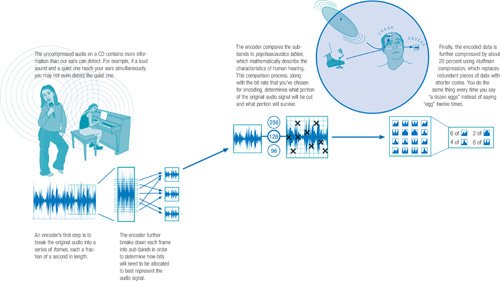How Audio Compression Works
| You don't have to understand how audio compression works in order to use iTunes, but you might wonder how an MP3 or AAC file can be roughly one-tenth the size of an uncompressed audio file and still sound nearly the same. MP3's origins go back to the 1980s, when researchers began exploring ways to reduce the storage requirements of digital audio. One of the standards that came from these efforts was MPEG (Moving Picture Experts Group) Audio Layer IIIMP3 for short. AAC is a newer kid on the block. Conceptually, AAC and MP3 are very similar: both reduce the storage requirements of sound by "shaving off" audio information that our ears have trouble hearing. But scientists have learned a lot about audio compression and human hearing in the decades since MP3 was created, and AAC takes advantage of these break-throughs to provide better sound quality at smaller file sizes. As for the Apple Lossless encoder, it doesn't "shave off" any audio information. Instead, it uses compression techniques that are similar to those of a file archiving program such as StuffIt. You don't save nearly as much space, but there's no loss in sound quality either. Will your ears be able to tell the difference? Do some tests and find out. One thing is certain: your hard drive and your iPod will know the difference. Apple Lossless files require dramatically more storage space than AAC or MP3 files. 
|
- Article 90 Introduction
- Article 400: Flexible Cords and Cables
- Annex C. Conduit and Tubing Fill Tables for Conductors and Fixture Wires of the Same Size
- Example No. D2(b) Optional Calculation for One-Family Dwelling, Air Conditioning Larger than Heating [See 220.82(A) and 220.82(C)]
- Example No. D4(b) Optional Calculation for Multifamily Dwelling
